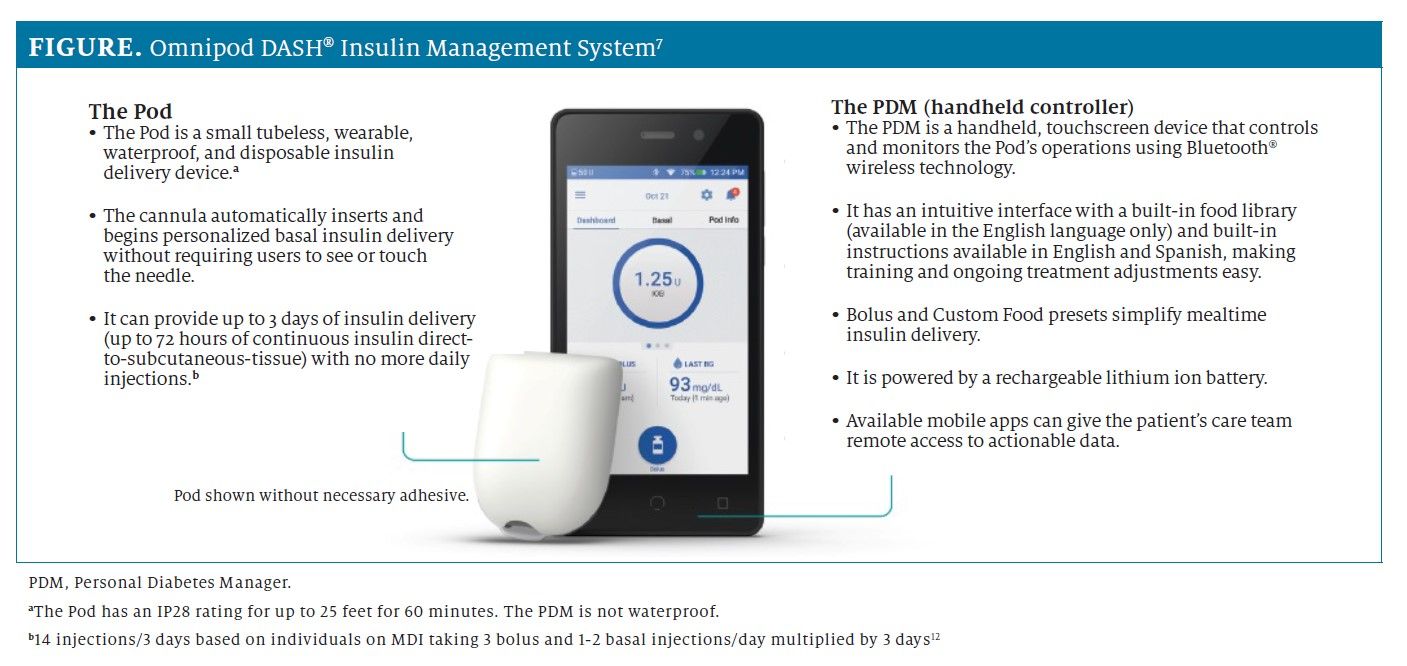Publication
Article
Pharmacy Times
Supporting Education on the Omnipod DASH® Insulin Management System in the Pharmacy
This article was sponsored by Insulet Corporation.
INTRODUCTION
Diabetes management technology has advanced beyond the historical methods of manually administered insulin and glucose monitoring with either a blood glucose meter or continuous glucose monitoring (CGM).1 New technology and tools are available for patients who inject insulin to simplify diabetes management and improve glycemic control.1,2
Insulin pump therapy is an option for patients with type 1 diabetes (T1D) or type 2 diabetes (T2D) who need multiple daily injections (MDI) and can safely use the pump themselves or with the help of caregivers.1 Depending on their individual needs, patients can use insulin pump therapy with or without CGM to help obtain their target glycemic levels.2
PATIENT CHALLENGES WITH DIABETES MANAGEMENT PLANS
Patients who experience challenges with their diabetes management plan (ie, adjusting their medication dosage to reach target blood glucose levels or experiencing discomfort with injecting insulin) may not adhere to insulin therapy and could experience regular hypoglycemic events.3,4 In a US-based survey of adults with T1D and T2D who inject insulin (N = 502), 57% reported skipping necessary insulin injections and 20% reported skipping them sometimes or often.5 Patients (especially those with Medicare Part D insurance) may lack access to valuable support resources, such as a community pharmacy, insurance, and device use training.1,6
According to the American Diabetes Association (ADA), use of insulin pumps by patients who require insulin may improve satisfaction and simplify therapy.1 Pharmacists can help simplify patients’ diabetes management plan by offering support, information, training, and titration on insulin delivery devices and patch pumps, including the Omnipod DASH® Insulin Management System.7
OMNIPOD DASH® INSULIN MANAGEMENT SYSTEM
The Omnipod DASH® Insulin Management System is a 2-part continuous insulin delivery system consisting of the Personal Diabetes Manager (PDM; a wireless, smartphone–like controller device) and a wearable Pod that delivers insulin (FIGURE).7 It is easy to use, discreet, and wearable, which simplifies life by eliminating MDI and simplifying mealtime math.7

When counseling patients, provide these 3 steps to start the system7:
Step 1. Patients or caregivers fill the Pod with rapid-acting insulin and place it almost anywhere insulin can be administered. The Omnipod DASH® is safe for use with the following U-100 rapid-acting insulin: NovoLog®, Humalog®, Apidra®, Fiasp®, Admelog®, or Lyumjev®.
Step 2. The cannula automatically inserts and begins personalized basal insulin delivery. There is no need to touch or see the insertion needle with the auto-cannula feature, which is ideal for patients with dexterity issues or needle phobias.
Step 3. The Pod simplifies insulin delivery through bolus options in a few taps. It contains simple mealtime bolus options to meet patients where they are, using a sliding scale, counting carbohydrates, or using the built-in CalorieKing food library. Bolus presets can be based upon a sliding scale or small, medium, or large meals. The bolus calculator option allows patients to enter in grams of carbohydrates and glucose value. Also, the calculator can factor in the amount of insulin on board from a previous bolus to prevent stacking of insulin.
Clinical Data
The results from several studies demonstrated clinical benefits in patients with T1D and T2D with the use of the Omnipod® System and Omnipod DASH®.8-10 These studies evaluated changes in glycated hemoglobin A1c (HbA1c), changes in total daily dose (TDD) of insulin, and self-reported frequency of hypoglycemic events.8,9
Results from a multisite retrospective study (3 months [N = 3592]) showed that the percentage of patients with T2D who met the ADA-recommended target of HbA1c levels of below 7% more than doubled (10%-22%, P < .0001) when they switched from MDI, tubed insulin pumps, or unknown diabetes management to the Omnipod® System or Omnipod DASH®. Patients with higher baseline HbA1c levels experienced a greater reduction in HbA1c at follow-up. Also, patients with prior MDI use experienced a 35-unit reduction in TDD of insulin. The weekly number of self-reported hypoglycemic events decreased from 1.2 to 0.7 (P < .0001).8
Similarly, results from 2 separate multicenter retrospective studies (3 months [N = 873] and 12 months [N = 156]) demonstrated reductions in HbA1c among patients with T1D who switched from continuous subcutaneous insulin infusion (CSII) with tubing or MDI to the Omnipod® System or Omnipod DASH®. Patients in the 3-month study reported significant decreases in linking to self-reported hypoglycemia frequency and severity (P < .001).9,10
Regarding quality of life, results from a survey of users with T2D showed that the top 3 reasons for switching to the Omnipod System® or Omnipod DASH® were a desire for better glycemic control (25%), a desire to not be tethered to tubing (24%), and a desire to replace the discomfort and hassle of injecting (16%).8 Furthermore, responses to a survey of 140 health care professionals indicated that 74% believe Omnipod DASH® improves adherence to pump therapy among patients with T1D and T2D switching from MDI.11
ROLE OF THE PHARMACIST
As an integral part of the health care team, pharmacists can identify patients who may benefit from insulin delivery devices and technologies that help simplify diabetes management care plans. These patients may include those who are nonadherent, have not reached their target HbA1c and desire better glycemic control, or prefer to not inject insulin. Pharmacists can identify these patients by inquiring about dosage schedules, reviewing refill records, discussing patient glycemic goals, and ensuring patient understanding of treatment, injection technique, and hypoglycemia. Pharmacists may support these patients by providing education on the Omnipod DASH®.
Access and Affordability
Pharmacists should be aware of insurance status and affordability considerations that affect access. Omnipod DASH® is the only full-featured insulin pump in the United States that is widely available through pharmacies. Omnipod DASH® is covered by commercial insurance, Medicare Part D insurers, and select Medicaid programs. If pharmacy coverage is denied, medical coverage may be available. On average, the co-pay for Omnipod DASH® through the pharmacy channel is less than $50 per month.7a Also, the average monthly out-of-pocket cost for Omnipod DASH® is lower than MDI regimen.7b Actual out-of-pocket co-pay amounts depend on patients’ health plans and coverage.
Omnipod DASH® is the only insulin pump covered through Medicare Part D, which includes coverage for both T1D and T2D (without C-peptide level tests or blood glucose logs required), a streamlined electronic fulfillment process that can reduce paperwork and expedite the Pod initiation process, co-pays that patients can pay as they go, and (typically) no switching restrictions. Convenient retail pharmacy pickup is available as well as delivery to the same pharmacy that carries the patient’s insulin. This helps provide continuity of care for patients with MDI who can benefit from Pod therapy now and when they reach 65 years of age.7
Dispensing Considerations and Getting Started
Insulet, the maker of Omnipod DASH®, supplies the PDM free of charge with the first box of Pods. Customers will be eligible to receive 1 free PDM every 4 years with the purchase of Pods. This may be subject to certain conditions including, but not limited to, verification of insurance. Insulet also offers virtual and in-person device training, which is required for new users for individualized setup. Pharmacists can refer patients who are new users to contact Insulet at 1-800-591-3455 to receive their PDM and schedule their training. Patients can also visit omnipod.com/training.7
To learn more about Omnipod DASH®, including unique features, clinical guidelines, and improved outcomes data, watch this webinar by Leslie Barrett, MS, RD, Senior Manager of Clinical and Professional Education at Insulet Corporation.
IMPORTANT SAFETY INFORMATION
The Omnipod DASH® Insulin Management System is intended for subcutaneous delivery of insulin at set and variable rates for the management of diabetes mellitus in persons requiring insulin. The Omnipod® DASH has been tested and found to be safe for use with the following U-100 insulin: NovoLog®, Humalog®, Apidra®, Fiasp®, Admelog®, or Lyumjev®. Refer to the Omnipod DASH® User Guide at omnipod.com for complete safety information, including indications, contraindications, warnings, cautions, and instructions. Please click here for Pharmacist Quick Reference Guide to Omnipod DASH.
7a: Average calculated based on a consumption of ten (10) Pods per month. 75,280 paid claims between January 1st, 2020 and December 31st, 2020 for commercial plans were analyzed. Actual co-pay amount depends on patient's health plan and coverage, they may fluctuate and be higher or lower than the advertised amount on a monthly basis.
7b: Estimated total monthly out-of-pocket (OOP) for Omnipod DASH® System regimen is $72, versus $84 to $85 for MDI regimens. Omnipod DASH® System OOP cost based on the co-pay cost for rapid-acting insulin (RAI) vial, Pods and alcohol wipes. MDI OOP cost based on the co-pay cost of RAI and long-acting insulin (LAI) vials (or LAI Pen and RAI Pen in the case of an MDI Pen regimen), alcohol wipes and syringes or needles (in the case of an MDI Pen regimen). MDI regimen co-pays based on 3 daily injections. All Omnipod DASH® estimates based off both commercial and Medicare paid claims between January 1st, 2020 and December 31st, 2020. Does not include any OOP related to CGM/blood glucose monitoring supplies. For illustration purposes only, actual co-pay amount depends on patient's health plan and coverage.
REFERENCES
- American Diabetes Association. Diabetes technology: standards of medical care in diabetes-2021. Diabetes Care. 2021;44(suppl 1):S85-S99. doi:10.2337/dc21-S007
- Grunberger G, Sherr J, Allende M, et al. American Association of Clinical Endocrinology Clinical Practice Guideline: the use of advanced technology in the management of persons with diabetes mellitus. Endocr Pract. 2021;27(6):505-537. doi:10.1016/j.eprac.2021.04.008
- Pantalone KM, Misra-Hebert AD, Hobbs TM, et al. The probability of A1C goal attainment in patients with uncontrolled type 2 diabetes in a large integrated delivery system: a prediction model. Diabetes Care. 2020;43(8):1910-1919. doi:10.2337/dc19-0968
- Centers for Disease Control and Prevention. National diabetes statistics report 2020: estimates of diabetes and its burden in the United States. August 28, 2020. Accessed September 24, 2021. https://www.cdc.gov/diabetes/pdfs/data/statistics/national-diabetes-statistics-report.pdf
- Peyrot M, Rubin RR, Kruger DF, Travis LB. Correlates of insulin injection omission. Diabetes Care. 2010;33(2):240-245. doi:10.2337/dc09-1348
- Sarbacker GB, Urteaga EM. Adherence to insulin therapy. Diabetes Spectr. 2016;29(3):166-170. doi:10.2337/diaspect.29.3.166
- Data on file.
- Carlson AL, Huyett LM, Jantz J, Chang A, Vienneau T, Ly TT. Improved glycemic control in 3,592 adults with type 2 diabetes mellitus initiating a tubeless insulin management system. Diabetes Res Clin Pr. 2021;174:108735. doi:10.1016/j.diabres.2021.108735
- Mehta SN, Tinsley LJ, Kruger D, et al. Improved glycemic control following transition to tubeless insulin pump therapy in adults with type 1 diabetes. Clin Diabetes. 2021;39(1):72-79. doi:10.2337/cd20-0022
- Layne JE, Parkin CG, Zisser H. Efficacy of the Omnipod insulin management system on glycemic control in patients with type 1 diabetes previously treated with multiple daily injections or continuous subcutaneous insulin infusion. J Diabetes Sci Technol. 2016;10(5):1130-1135. doi:10.1177/1932296816638674
- 74% of HCPs believe that the Omnipod DASH® System improves adherence to pump therapy among Type 1 and Type 2 patients switching from MDI. Based on the HCPs survey, conducted in November 2020. 140 HCPs were surveyed to gauge the practical experience of Omnipod DASH® System use. Seagrove Partners, LLC, 2020.
- Chiang, Kirkman MS, Laffel LMB, et al. Type 1 diabetes through the life span: a position statement of the American Diabetes Association. Diabetes Care. 2014; 37(7): 2034-2054. doi:10.2337/dc14-1140


